Neat video showing off characters from the 8-bit era. C64 and Nintendo fans will recognise some favourites!
1500 hours of moving legobricks and take photos of them.
(via Justin and Retro Thing)
Neat video showing off characters from the 8-bit era. C64 and Nintendo fans will recognise some favourites!
1500 hours of moving legobricks and take photos of them.
(via Justin and Retro Thing)
A few weeks ago I splashed out on a 60GB Xbox 360, going for a reasonable 200 Euro in HMV and luckily for me I was able to enjoy the HD graphics of this next gen (next gen? It’s 4 years old now but the hardware specs are impressive!) console. Actually, “enjoy” is putting it lightly. Blown away, gobsmacked and amazed are probably better ways of describing my reaction to some of the graphics I saw this machine throwing about! Sometimes it feels like I’m taking part in one big movie.
I miss the Wiimote, I hope Microsoft do bring out a magic wand sooner or later.
One of the great things about being a late adapter is that I can buy most of the games I want in the pre-owned section. Instead of spending 50 Euro they sometimes cost half that!
I’ve gone searching for Xbox 360 blogs but only found a couple that weren’t full of adverts or blatantly self serving. I must be using the wrong keywords. Xbox fans, what are your favourite Xbox blogs?
30 or so years ago the first computer that I remember was a games console. I don’t remember the brand although my brother says it was an Atari. It was a simple machine, with a slot for a game cartridge. It had two grey boxy analog paddles, each with slender sticks and a small red button. Each controller would slot into a space in the console for easy storage. We only had one cartridge, a compilation of “sports” games, but as the machine used stick graphics they were fairly simplistic.
I remember the tennis game with two bats and a single large white pixel of a ball provided hours upon hours of entertainment for us kids.
What followed after that were more serious computers, the Commodore Vic 20, Speccy 48k, Commodore 64, Amiga 500, various PCs running Win 3.1, win 95, 98, Linux, and finally a Macbook and a Dell laptop running Ubuntu Linux. I didn’t own a console until I bought a Nintendo Wii, and then 2 weeks ago the Xbox 360.
Of the Vic 20, I remember typing in a BASIC programme that displayed a simple animated bird that flew around the screen. As we didn’t have a Datasette I couldn’t save it. I left the Vic 20 on while I went to school!
My son Adam’s first memories of games will probably be the Xbox. A far cry from the black and white stick characters of my youth!
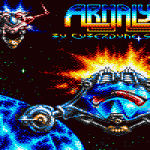 This game should need no introduction to Commodore 64 fans, but for the rest, Armalyte is one of the best shoot ’em ups on that amazing home computer.
This game should need no introduction to Commodore 64 fans, but for the rest, Armalyte is one of the best shoot ’em ups on that amazing home computer.
The great news is that it’s finally seeing an officially approved remake from Psytronik in the UK. It’s due out later this year. Check out the following video for a taste of what’s to come. I hate to use this word, but all I could think of was, “Awesome!” when I watched it.
Did you notice they fixed the 3D bug in the main menu?
There’s more! Last week Gabe McGrath got in touch and told me he interviewed the three guys behind the remake: Stuart Collier, Trevor ‘Smila’ Storey and Chris ‘Infamous’ Bailey. It’s an entertaining and interesting read. Nice screenshots of each version side by side.
I didn’t know Retro Gamer had published a “making of” article on the original game. Must go dig out the RG DVD to read it.
Fingers crossed they decide to do a Mac or Linux version. Please don’t make me reboot into Windows just to play a game!
Many years ago I mentioned Armalyte here when I rediscovered emulators and an active online C64 scene. Still active!
 This isn’t the first time a Commodore 64 laptop has been made but it’s probably the coolest one. Commodore’s original SX 64 was built in 1984 and featured a tiny 5 inch CRT screen with a hardly portable body weighing in at 10kg!
This isn’t the first time a Commodore 64 laptop has been made but it’s probably the coolest one. Commodore’s original SX 64 was built in 1984 and featured a tiny 5 inch CRT screen with a hardly portable body weighing in at 10kg!
I actually saw an SX 64 years ago in Cork Micro, the small computer shop run by the late Sean Bossang in Cork.
 A couple of years ago there was the Picodore, a tiny little laptop built from the innards of a C64 DTV joystick. The keyboard’s a little small for my tastes though!
A couple of years ago there was the Picodore, a tiny little laptop built from the innards of a C64 DTV joystick. The keyboard’s a little small for my tastes though!
 And finally, Benjamin has created a real, “normal sized” laptop from the motherboard of a C64C, the final version of the C64 built by Commodore.
And finally, Benjamin has created a real, “normal sized” laptop from the motherboard of a C64C, the final version of the C64 built by Commodore.
It uses the original keyboard too, and “1541-III DTV” to emulate the original 1541 disk drive. This device takes FAT32 formatted SD cards so you can copy D64 images from your PC on to it, insert the card in the laptop and load them immediately. Judging by the movie below, he needs an Action Replay cartridge or something to speed up loading. The emulated drive emulates the slow loading of the original drive too well methinks.
Nice to see Thunderblade make an appearance. I’m sure I have the original C64 tape of that game around here somewhere..
More info on Ben’s post.
VirtualC64 is a new Commodore 64 emulator for Mac OS X. It’s a promising project, let down by the fact that it’s still in beta but by the looks of things development is moving at a steady pace.
When you first run the emulator it will ask you for C64 roms: basic, kernal, chargen and vc1541. Ironically, you can find all these roms inside Vice, another C64 emulator. Look in /Applications/VICE.app/Contents/Resources/ROM/. The 1541 ROM is DRIVES/dos1541.
Loading a game or demo is as easy as dragging the d64 or t64 image into VirtualC64. When you do you’ll see a dialog like this.
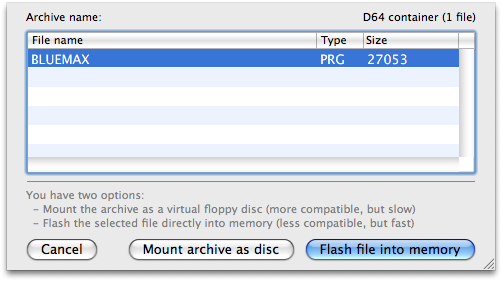
“Flash file into memory” works great for single load programmes but multiload could be a problem. I tried Armalyte. Mounting the d64 as a disk didn’t work. I couldn’t type anything. Loading the first file on the disk by flashing it brought up the crack intro but failed to load. The neat integrated debugger (click “Inspect”) showed the emulator had died doing jsr $2020 and unfortunately at 2020 was another jsr … ($20 is the character code for a space if memory serves, and the machine code for jsr was $20, so memory was full of spaces!)
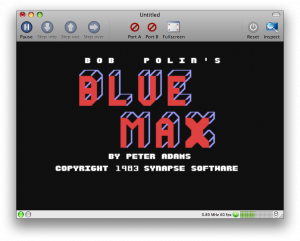
Blue Max worked much better, as did a 3D Pool game I tried. the crack by Remember included the documentation and again using the debugger I watched as the programme checked for the various key presses. Geeky I know but it brought a smile of recognition to my lips. Here’s that debugger in all it’s glory. Anyone familiar with the C64 should recognise the code beginning at 1AA0. (I had to look up what D016 does. It’s the screen mode. I had completely forgotten. It’s only been 16 years.)
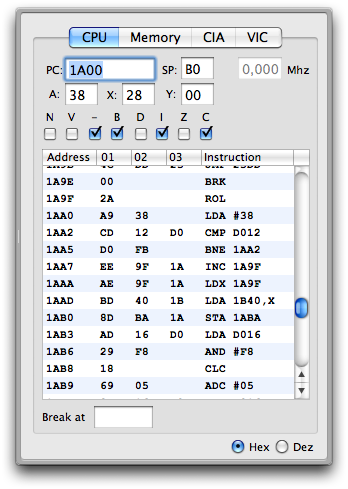
One thing it has going for it over Vice, is a real fullscreen mode. The current version of Vice uses some dodgy resolution changing in Linux (that I rarely got to work properly without screwing up my desktop) and I couldn’t get to work in Mac OS X at all. Fire this baby up in fullscreen mode and you’ve got your very own C64 laptop! Cool or what eh?
As luck would have it VirtualC64 has blown a fuse just as I finish this post. If you have a usb joystick plugged in and activated in port 2 it does strange things. First the keyboard wouldn’t work, and flashing a file didn’t run it automatically. Then the keyboard sort of worked but the left arrow character appeared for most key presses. Odd stuff. Unplugging the joystick and restarting the emulator fixed that problem.
Even my Bits ‘n’ Bobs demo worked in it! (Bah, all my screenshots failed. They only show white. I wonder if the emulator does strange things to the Mac while emulating mixed video modes? I mixed character and video modes in the screens I tried to capture, ah well.)
VirtualC64 is a very promising C64 emulator, and it’s GPL too! I’ll certainly be keeping an interested eye on it, and I wish Dirk and the other project members the best of luck with it.
This blew me away the first time I heard it. The title tune of classic C64 game Wizball recreated by Reyn Ouwehand. You could watch the embedded movie, but for the full stereo HD experience take a look at the high quality version on Youtube. Reyn explains why he did it:
I also play this track in my C64 live-set but then I got some beats and the arpeggios coming out of Ableton Live. During the live show I couldn’t get Ableton to work and it kept on crashing on me and then Leoni challenged me to do it acoustically without the computer. And so I did….
Truth be told I never got too far in Wizball. It’s a strange shoot-em-up that has many fans and I’m strangely intrigued by it.
There’s even a remake of Wizball for the Mac and Windows. I’ve played it on the Mac and it’s brilliant. The title tune (by Infamous is spot on, graphics are stunning, and gameplay is as I remember it. Very odd and just a bit frustrating and hard.
You can read more about Wizball here or even download the original game on the Commodore 64 too.
C64 fans, get that guitar out and play along to your favourite SID tunes with Shredz64. It uses a small circuit called the PSX64 interface to connect Playstation controllers to the old Atari or DB9 joystick interface on old computers like the C64, Amiga, Atari ST, Speccy (with the right interface itself!)..
There are two videos, the first is an explanation of the whole thing, showing the C64 connected to the Guitar Hero guitar and the game loading SID files off a disk. The second video, after the jump, is a demo of Shredz64 itself. Not quite as fancy as Guitar Hero or it’s ilk, but impressive enough!
Continue reading “Shredz64 – Guitar Gero on the Commodore 64”
Several months ago my old C64 buddy, Andrew Fisher, emailed me to tell me about his new book, The Commodore 64 Book – 1982 to 199x. At the time his email fell through the cracks in the Thunderbird inbox and was destined to remain unanswered until I received a reply from another friend, Iain Black, curator of The Def Guide to Zzap!64 to a recent email I sent him. He asked if I had heard from Andrew so I went digging and found Andrew’s correspondence.
I’m glad I did. I just visited his site and ordered my copy of his book. I’m looking forward to getting my hands on it and poring over all the reviews and little nuggets of retro goodness. If you were ever a fan of the C64, I think you owe it to yourself to splash out the couple of quid this books costs so you can bore the pants off your significant other, your work colleagues or friends with hopelessly antiquated nonsense from 20-30 years ago!
For the Speccy fans, there was The ZX Spectrum Book – 1982 to 199x but unfortunately only 1000 were ever printed and it’s sold out.
In 1982, the Commodore computer company launched its new machine – the Commodore 64.
Twenty five years later, that machine is still going strong with new games and thousands of users worldwide.
To tell the story of the best-selling home computer of the 1980’s, writer and Commodore 64 fan Andrew Fisher looks back at around two hundred of the top games and how the industry has changed. From the pioneering third party companies like Electronic Arts and Melbourne House, to the homebrew software of the new millennium, the story of an 8-bit computer (and its remarkable sound chip) is a nostalgia trip for games fans.
Yes, difficult as it may seem, but people are still coding on the C64. I presume most of them work on emulators and I remember reading a forum post from a young guy who had never owned the machine but wanted to learn 6502 assembler. The C64 Scene Database lists almost every single demo produced and new ones are being added all the time. Not bad for such an old machine eh?

.C:2101 A9 3A LDA #$3A .C:2103 CD 12 D0 CMP $D012 .C:2106 D0 FB BNE $2103 .C:2108 A2 09 LDX #$09 .C:210a CA DEX .C:210b D0 FD BNE $210A .C:210d A2 00 LDX #$00 .C:210f BD 00 09 LDA $0900,X .C:2112 8D 21 D0 STA $D021 .C:2115 8D 20 D0 STA $D020 .C:2118 BC 00 0A LDY $0A00,X .C:211b 88 DEY .C:211c 10 FD BPL $211B .C:211e E8 INX .C:211f E0 65 CPX #$65 .C:2121 D0 EC BNE $210F .C:2123 A2 01 LDX #$01 .C:2125 CA DEX .C:2126 D0 FD BNE $2125 .C:2128 A9 00 LDA #$00 .C:212a 8D 20 D0 STA $D020 .C:212d AD 21 D0 LDA $D021
So, who knows what’s happening above? Come on, it’ll come back to you if you look at the screenshot! I found a great tutorial on C64 demo coding. Unfortunately it’s a 404 now, but Google cached it and I downloaded it here for safe keeping: intro-to-programming-c64-demos.html
Look for the part on $d012
$d012 might be the most important address of them all, when it comes to demo programming on the C-64. $d012 has two different functions:
* When read, it returns the number of the current raster line.
* When written, it is used to set the number of the line where the next raster interrupt will occur.We’ll get back to raster interrupts later. You need to know about $d012 to understand them, so pay attention to the stuff in this section! The first item above is interesting, but it may not be obvious why it is interesting.
The current raster line is the line that is currently being redrawn on your screen. The whole screen is redrawn 50 times per second. Each time it is redrawn from top to bottom, from the left to the right. So, if you want something to happen 50 times per second, all you have to do is to check the current value of $d012, and when it reaches a certain value, call the routine that performs the desired task. When finished, go back to checking $d012.
That blew me away when I found out about that. You could literally change the background colour of the screen halfway down the screen, have multiple text and graphics modes, use more than the default 8 hardware sprites. The PC was disappointing in comparison.
That code above is for Justin who reminded me that Vice has an ASM monitor!
I used to go by the handle, “Xeer”. It’s under that name that I coded Commodore 64 demos many years ago. There’s even an entry for me on the C64 Scene Database! Exciting times then, but I’ve often been asked where the name Xeer came from. Now I can reveal it’s very obscure origins.
You may have heard of a space trading game called Elite that was released in 1985. If you haven’t, then don’t worry. You’re a youngster aren’t you? It made serious waves in the games scene for many years and even spawned an awful sequel on the PC a couple of years ago.
Anyway, I came across the game a few years after, probably in 1988 or ’89 and was hooked! I have to be honest, I preferred the shoot-em-up parts to the dry and boring trading bits. Games never lasted very long but it made a lasting impression on me.
One thing led to another, and I became interested in the C64 demo scene, but I needed a handle. Luckily I came across a few cheats for Elite that gave me infinite fuel or some such other nonsense and went looking around the galaxy. Here’s what the galaxy looked like back in the late 80’s.
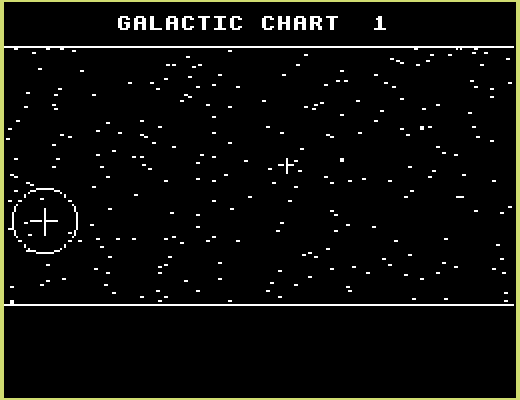
While exploring, I came across the little planet under the cursor above. Can you guess what it’s called? Yup, Xeer. Here’s the info sheet on it.
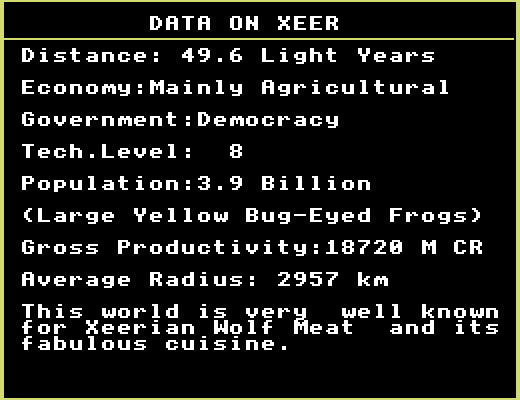
I haven’t seen any large yellow bug-eyed frogs about anywhere but I expect they’ll show up sooner or later.
More Xeer trivia: The traditional Somali Constitution is called Xeer, although the linked page on combackalive.com makes little sense to me. Anyone from that region know more?
For the Elite fans: The Zzap64! review.